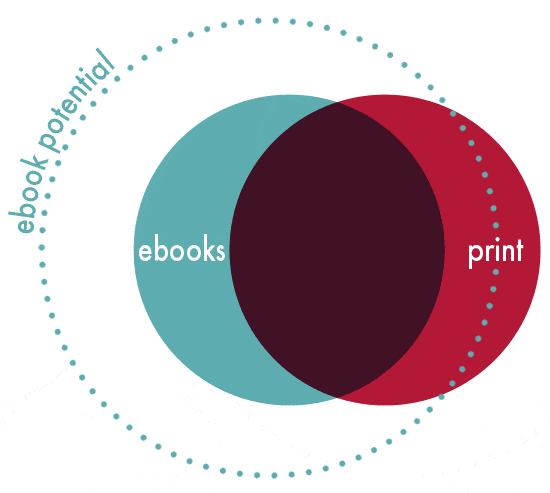Closing the gap to print
 The diagram above represents the characteristics of ebooks vs those of print. At present, the picture is finely balanced, requiring the reader to accept a trade-off when deciding between the two. But while the print book is pretty much a fully-evolved format, there is huge scope for the development of ebooks. The greatest potential lies in areas impossible in print. However, as things stand, almost all ebook content has been conceived with print as the primary delivery mechanism. This makes the areas in which print outshines the electronic format crucial.
The diagram above represents the characteristics of ebooks vs those of print. At present, the picture is finely balanced, requiring the reader to accept a trade-off when deciding between the two. But while the print book is pretty much a fully-evolved format, there is huge scope for the development of ebooks. The greatest potential lies in areas impossible in print. However, as things stand, almost all ebook content has been conceived with print as the primary delivery mechanism. This makes the areas in which print outshines the electronic format crucial.
Let’s look at some of print’s innate properties that give it an edge, and see how ebooks can evolve to tip the balance in their favour.
Typography
Print is fixed, and as such can be fixed in ways that are beautiful and, more importantly, maximise readability. Electronic text can be resized and reflowed on the go; an invaluable asset to readers with visual impairments. But the results are often crude and ugly, detracting from function as well as aesthetics. Smarter text flowing software coupled with greater processing power can go a long way to tackling this problem, provided there is serious recognition among publishers and readers that it is a problem that needs tackling, and not just something for design geeks to get hot under the collar about.
Right now, if you can comfortably read a book at the size it is set, print wins this one hands down. When typographic rigour can be brought to fluid text on a screen, even if it never quite matches the precision of a skilled human typesetter, the added flexibility will make ebooks the net winner in this category.
Disposable Longevity
A book is something you can keep for a hundred years, or lose on the beach without filing an insurance claim.1 Conversely, ebooks combine ephemeral files that be unusable in a decade, with expensive technology you’d think twice about taking into certain environments.
Whether you want an object to cherish to years to come, or one you can take anywhere without worrying about the cost, pbooks win hands down at the moment.
So how can the gap be narrowed?
Technology tends to fall in price, and it’s certainly conceivable that basic ereaders will become so cheap as to be effectively disposable.2 Cloud-based storage and retrieval systems could address the problems of lost files and obsolete devices. For now though, ebooks with the same disposable longevity as pbooks seem a long way off.
An indivisible whole
Unlike music or films, when you buy a book, you don’t need a separate appliance in order to consume the content. A book is the equivalent of a CD or DVD that plays itself.
Not so with the ebook. An epub, a PDF or any other electronic format is useless without an expensive device on which to display it. This separation of device and content changes our relationship with the book, dividing our response to it in two. This presents a problem for publishers. Faced with the shortcomings of ebooks compared with their printed cousins, consumers are apt to blame the file, and the company that supplied it. But when considering the benefits – such as the ability to store and transport many books, to search the text and look up words – they may well ascribe that value to the shiny new device they spent a large sum of money on.
The net result? Despite being sold on the benefits of ebooks, the consumer feels that as purchases, they are worth less than their printed counterparts.
This is not the first time content and device have been separated – audiobooks have been around for years, and consumers have accepted them as a higher priced alternative to print. So what are the lessons here?
First, most people already have music playing equipment of some kind, so although audiobooks require a delivery device, in most cases they don’t require a big-ticket purchase in order to try one for the first time. With ebooks, it is the multifunctional devices we own, or will own, anyway – mobile phones, tablet computers – rather than dedicated ereaders, that provide the simplest introduction to electronic reading.
Secondly, audiobooks provide an experience that is sufficiently distinct from reading from the page to justify the expense. It’s not only the ability to ‘read’ while driving, running, or ironing. A good reader adds something to a book that simply isn’t available in any other format.
That’s what ebooks will evolve into: an experience unique to its format and unavailable in any other.
Expanding the scope of ebooks
Ebooks can, and should, go further in replicating some of the properties of print – improvements in typography and some mechanism for assuring longevity would be huge steps – but there will always be a portion of the print experience that remains unique to print. However, ebooks are already developing capabilities unavailable in print, and there remains huge scope for further expansion in this direction.


Leave a Reply